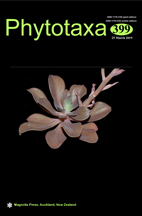Abstract
In the present study, two new species of Nitzschia Hassall, Nitzschia pusilluhasta sp. nov. and Nitzschia australodesertorum sp. nov. are described from reservoirs in the state of São Paulo southeast Brazil. The morphology of the new species was analysed using light and electron microscopy. Nitzschia pusilluhasta is distinguished from morphologically related species by its valve outline, the shape of apices and fibulae, the absence of a gap between central fibulae, and the density of striae and areolae. Nitzschia australodesertorum differs from morphologically similar species in its valve outline, the shape of apices and fibulae, the presence of a gap between the central fibulae, and the density of fibulae and striae. The morphology and ecology of the new species are discussed and compared with morphologically related taxa. Information on the co-occurrence of other diatom species in the samples is also provided.

